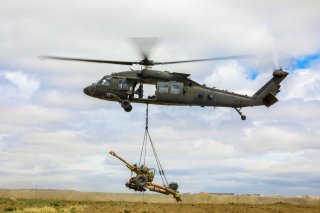The Army’s Project Convergence Takes Targeting to the Speed of Light
What happens if the time it takes to identify a target and choose the optimal weapon to destroy it decreases from twenty minutes to twenty seconds?
When a mini-drone can penetrate enemy air space and instantly send target specifics to a larger drone in position to relay data to an attack helicopter, ground-based AI-enabled computer, or even land weapons systems, it is time for a new U.S. Army combined arms maneuver approach.
Such is the thinking of Army weapons developers now surging into the third year of the breakthrough Project Convergence “Campaign of Learning,” which, starting in 2020, began to inform and even reshape Army doctrine and concepts of operation, generating new applications of combined arms maneuvers.
Senior weapons developers explain combined arms almost in terms of a symphony, meaning each element operates in close coordination with the others. In effect, the operational concept is to have artillery, air support, mechanized armor, and infantry all conduct missions with the intent of performing a specific operational role that has a devastating effect on the enemy. For example, artillery and air support strike from stand-off distances in advance of mechanized units closing in on an enemy, or, as the Army calls it, “moving to contact.” Each element, including surveillance drones, attack helicopters, longer-range rockets, and artillery, is by design employed to support advancing armored units and infantry. The timing is carefully coordinated to maximize impact upon an enemy.
What happens, however, if the time it takes to identify a target and choose the optimal weapon to destroy it decreases from twenty minutes to twenty seconds? That is the cutting-edge question, as the Army’s Project Convergence succeeded in doing so through a range of replicated combat scenarios at Yuma Proving Grounds in 2020.
“We think about combined arms all the time. If we don’t find a venue to get out and experiment in this combined arms environment in the dirt with soldiers and engineers, then we are missing an opportunity,” Maj. Gen. John Rafferty, director of the Long Range Precision Fires Cross-Functional Team at Army Futures Command, told the National Interest in an interview. This initial breakthrough, which demonstrated paradigm-changing, high-speed attacks, has further evolved in recent years to become both joint and multinational.
Convergence is as it sounds, meaning otherwise disparate pools of information from sensors are aggregated, organized, and analyzed by an AI-enabled computer called Firestorm, and then transmitted to human decisionmakers with recommendations for which “effector,” or weapon, might be best suited for a particular target. The AI-capable process is able to bounce new incoming information off of a vast database, analyze and compare key variables in relation to one another, identify key moments of relevance, and offer solutions in a matter of seconds. All of this, Rafferty explained, can be brought to life through Project Convergence experimentation, which places soldiers in the “dirt” to replicate actual combat scenarios.
“The Convergence Campaign of Learning is the forcing function for making sure that we don't get lost in these, you know, silos of fires or network or Future Vertical Lift or Next Generation Combat vehicle. We're forced to put this in a combined arms environment with soldiers and then evaluate,” Rafferty said.
Kris Osborn is the defense editor for the National Interest. Osborn previously served at the Pentagon as a Highly Qualified Expert with the Office of the Assistant Secretary of the Army—Acquisition, Logistics & Technology. Osborn has also worked as an anchor and on-air military specialist at national TV networks. He has appeared as a guest military expert on Fox News, MSNBC, The Military Channel, and The History Channel. He also has a Master's Degree in Comparative Literature from Columbia University.
Image: Flickr/U.S. Army.

